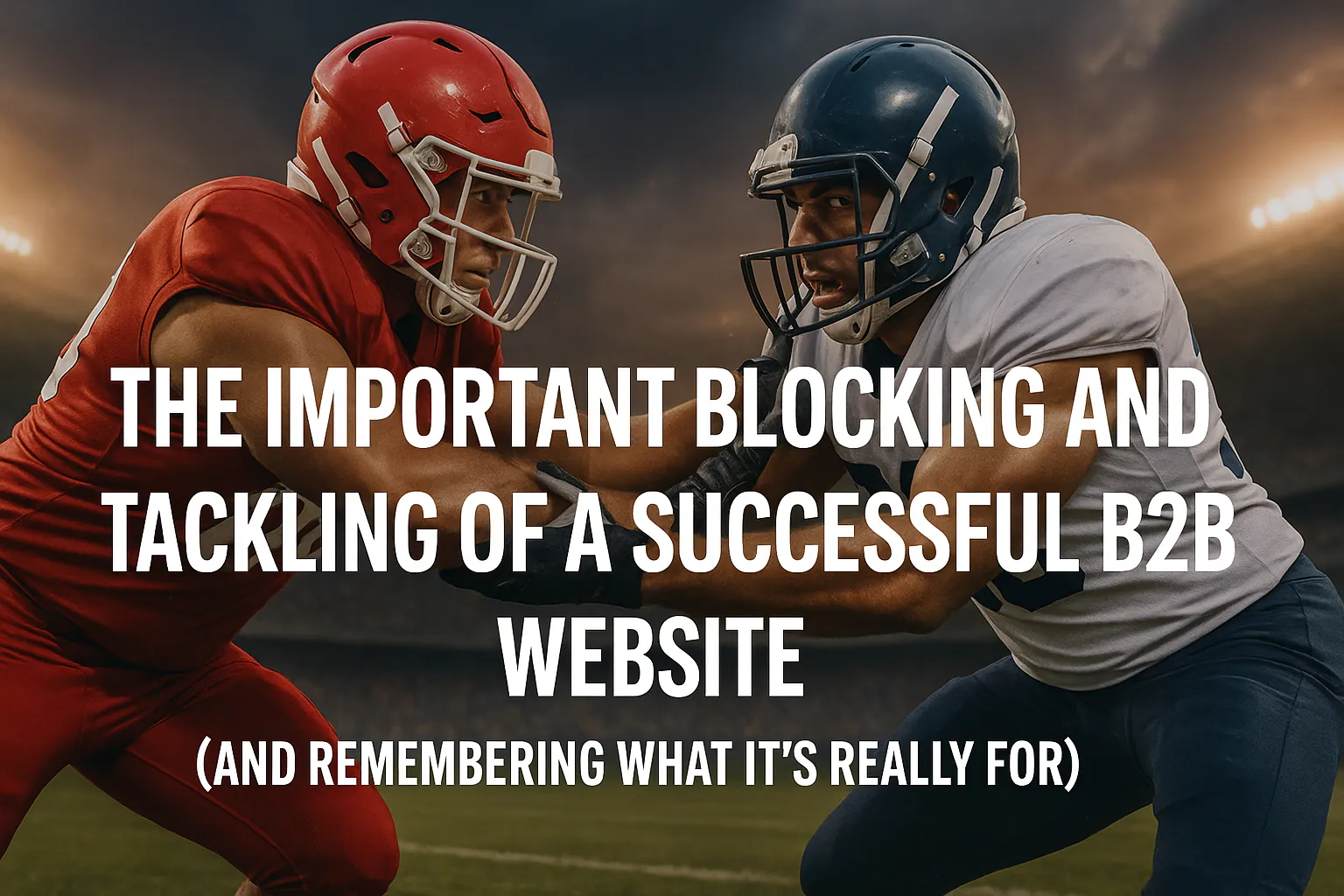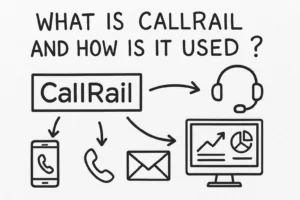What we’ll cover in this article
- The real job of a B2B website (trust, education, conversion)
- A sequenced checklist of essentials—no fluff
- The “most missed” items (internal linking, breadcrumbs, canonicals, NAP, etc.)
- Simple ROI math you can share with your leadership team
- A short FAQ and next step you can act on today
A quick story to set the stage
It’s Monday, 8:17 a.m. Your CEO asks, “What are we getting from the website?”
You’ve got a beautiful design. But the pages load a little slow, the blog answers some questions—but not the ones sales keeps hearing—and forms feel… heavy.
This post is the coach in your ear. We’ll get you focused on the blocking and tackling that actually moves the pipeline.
First things first: what your B2B website is for
Cut through the noise. A B2B website exists to do three things well:
- Build trust (clear positioning, proof, and consistency).
- Educate buyers with content that answers their real questions—They Ask, You Answer.
- Convert attention into action with simple, pressure-free CTAs aligned to the buyer’s stage.
At Doceo, our model is built around those outcomes: plain-English guidance, measurable results, and stage-matched next steps.
The sequenced checklist
Think of this like a build order. Nail each layer before moving up.
1) Foundation & security (site you can trust)
- HTTPS everywhere with HSTS (forces secure connections; set the Strict-Transport-Security header). This reduces downgrade risks and enforces TLS in browsers.
- Backups & staging before major changes (so you can ship without fear).
- Uptime & error monitoring (know when pages 500/404 before your buyers do).
Doceo Pro Tip: Schedule small, weekly deployments. Big-bang releases create avoidable risk.
2) Crawl control & index hygiene
- robots.txt to manage crawl traffic (not for security) and XML sitemaps so Google can efficiently discover key URLs. Submit in Search Console.
- Canonical tags to prevent duplicate content problems across similar URLs.
- Redirects (301) for retired pages; avoid redirect chains.
- Internationalization: add hreflang only if you truly have localized versions.
3) Information architecture & navigation
- Straightforward menus that mirror how buyers think.
- Breadcrumbs for wayfinding and hierarchy (great for users, and Google still supports breadcrumb structured data—especially on desktop). Note: reporting suggests Google de-emphasized breadcrumb display on mobile results in 2025, but breadcrumb structured data remains recommended and visible on desktop.
- Internal linking: every important page should be linked from at least one other page; use descriptive anchor text (avoid “click here”).
Mini-scenario (realistic):
Add contextual links from your top 10 blog posts to the matching service pages and one Learning Center hub. Outcome over 90 days: more qualified sessions reach your forms (even without new content).
Doceo Pro Tip: Place one relevant internal link in the first 150–200 words when it makes sense—readers decide early whether to stay. (Keep anchors descriptive, not stuffed.)
4) Performance & device responsiveness
- Core Web Vitals: optimize LCP (largest element paint), CLS (visual stability), and INP (interaction latency). *Note: INP replaced FID as a Core Web Vital on March 12, 2024.
- Speed matters: as page load moves from 1s→3s, the probability of bounce jumps ~32% (mobile). Faster sites keep people reading and converting.
Doceo Pro Tip: test on throttled 4G, not office Wi-Fi. Fix the slowest template first (usually blog or product detail).
5) UX that favors clarity over flair
- Clear headline that says what you do and for whom.
- Comfortable spacing and readable typography.
- Accessibility: target WCAG 2.2 AA basics; it’s good UX and reduces risk.
6) Content that earns trust (E-E-A-T)
- People-first content, not search-engine-first. Use bylines, cite sources, include specific examples and numbers.
- Program your editorial calendar around buyer questions—pricing, comparisons, “what is,” “how to choose,” and “problems to avoid”.
- Format for scanning: question-led H2s, short paragraphs, and FAQ blocks for snippet potential.
7) Conversion paths: CTAs & easy forms
- Map Awareness → Consideration → Decision. Use stage-matched CTAs and keep forms short (name, email, one qualifier).
- Add helpful next steps on thank-you pages (related guides, a calendar link later if they’re ready) .
Internal link examples (placeholders to be mapped via the Internal Link Map):
8) Metadata & structured data
- Meta titles (≤60 chars) and meta descriptions (150–160 chars) for each indexable page.
- Structured data (Article, FAQPage, etc.) to help Google understand context.
- Open Graph & Twitter Cards so links share with the right image/title/description.
9) Local credibility signals (even for B2B)
- NAP consistency (Name, Address, Phone) across your site and profiles; many B2B deals start locally or regionally. Keep entries consistent in Google Business Profile and trusted directories.
10) Analytics, attribution & governance
- GA4 (events for form starts/submits) and Search Console for query/coverage insights.
- Content governance: a simple calendar; monthly link, and 404/301 review; refresh posts with decaying traffic.
Bonus: Platform confidence
If you’re on WordPress, you’re not alone—recent tracking shows it powers ~43% of all sites and ~61% of CMS-driven sites (updated daily). Translation: plenty of proven patterns and plugins for everything above.
Measuring what matters (and proving it)
Three numbers beat 30 metrics:
- Qualified organic sessions (the right visitors, not just more).
- Conversion rate (CVR): percent of visitors completing a meaningful action.
- Pipeline influenced: opportunities that touched the site.
ROI/Impact (simple math)
Additional pipeline = (extra qualified visitors × CVR lift) × avg deal value
Example:
- Monthly visitors: 5,000
- Qualified share: 60% → 3,000
- CVR lift after fixing speed + forms: +1% (from 1.5% → 2.5%)
- Avg deal: $8,000
Additional influenced pipeline/month ≈ 30 × $8,000 = $240,000
Common pitfalls to avoid (we see these weekly)
- Shipping a redesign without fixing INP/LCP first. Your new look won’t matter if it’s slow.
- Writing blogs that avoid pricing or comparisons. That’s what buyers search for.
- Skipping canonical tags, causing duplicates to outrank the “real” page.
- No internal links from blog → service pages (or vice versa).
- Forgetting Open Graph/Twitter Cards—your links look broken on social Media.
FAQ
What are the most important Core Web Vitals now?
LCP (loading), CLS (stability), and INP (interaction). INP replaced FID on March 12, 2024. Focus your fixes on the slowest templates first.
Do breadcrumbs still matter if Google hides them on mobile?
Yes. They still help users navigate and help Google understand hierarchy; breadcrumb structured data remains supported and shows on desktop.
What’s the point of canonical tags?
They tell Google your preferred URL among duplicates (e.g., tracking parameters), consolidating signals to the canonical page.
Why bother with NAP for B2B?
Many B2B searches carry local intent. Consistent NAP details support visibility and trust across listings.
How long should meta descriptions be?
Aim for 150–160 characters. They don’t rank you, but great copy improves click-through to your best content.
Ready to dig deeper?
Doceo’s Marketing Services Team is here to help. We can work as a trusted Advisor guiding your internal team, or manage your website top to bottom. Schedule a FREE consultation → Let's Talk





